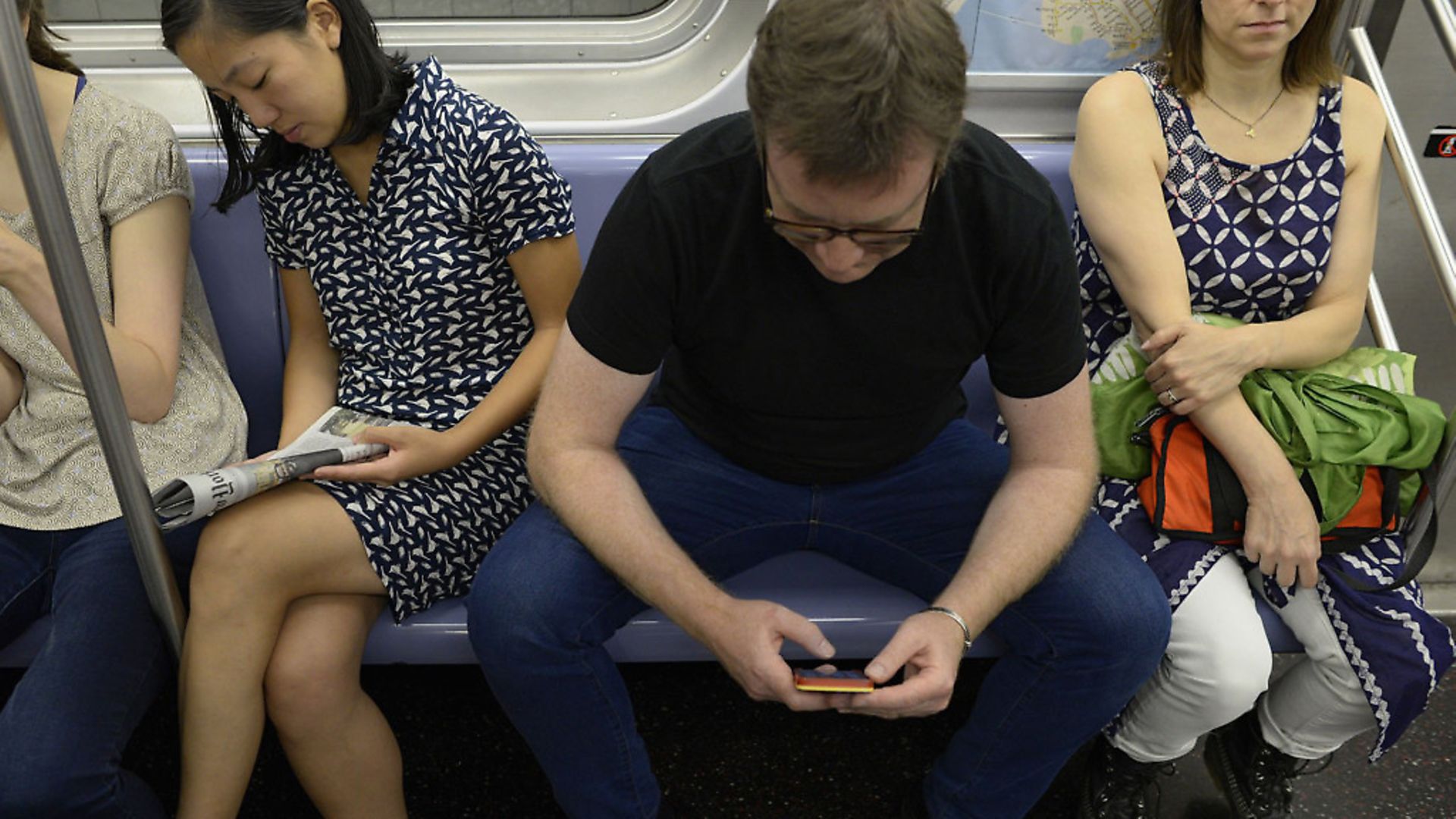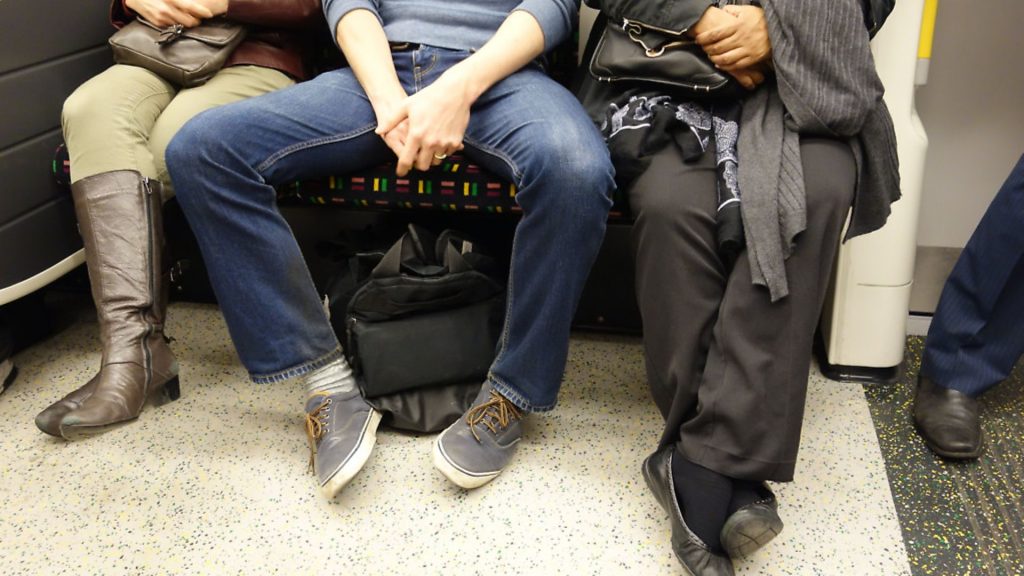
As Spanish women score a significant success against excessive space-taking by men, we find out why manspreading was an issue they felt needed addressing.

‘Manspreading’ is the neologism coined to label the practice of men sitting, usually on public transport, with their legs spread wide apart. Its etymology goes back just five years, when a campaign drawing attention to the practice launched on microblogging website Tumblr. There have since been a number of social media campaigns dedicated to highlighting this behaviour. Added to the Oxford English Dictionary in 2015, it has been both celebrated and lambasted; lauded for acknowledging men taking up excessive public space and criticised as an example of pseudo-feminism. But what informs this excessive space-taking? And why is this behaviour apparently idiosyncratic to men?
A Madrid-based feminist collective recently made headlines for their successful campaign against El Manspreading – resulting in them collaborating with the Spanish capital’s municipal transport company, the EMT, to produce a series of posters discouraging the practice. The posters features a figure with head hovering ominously over his torso; his legs spread wide, thoughtlessly encroaching into the space of the seat next to him. An angry red cross telegraphs the taboo nature of this stance.
‘This information sign is similar to those that already exist in other transport systems around the world,’ EMT said. ‘To stop people adopting a posture that makes others uncomfortable.’
Microrrelatos Feministas (translated as ‘feminist micro-stories) – the collective who spearheaded the campaign – began as an online feminist radio show titled Mujeres en Lucha (‘women at war’). The show was themed around everyday issues relevant to Spanish women: gender-based violence, the politics of surrogacy, that other ‘man’ prefixed neologism ‘mansplaining’. They begin talking about the show’s themes first from a national perspective, then roll out for discussion within a global context – and manspreading is indeed a global phenomenon.
I spoke with one of Microrrelatos Feministas spokespeople, Paula Aguilar, about why manspreading was an issue they felt needed addressing, how their campaign came to be, and why they think men have a tendency to adopt this position.
‘We did a segment on manspreading and thought ‘this is an issue we could actually do something about’. And so we began an online petition.’
The petition went viral on Twitter and they presented it to Madrid’s City Hall. It so happened their campaign came at a time when the city council were looking at updating their public transport messaging – and two days later the collective began collaborating to produce the signs.
‘The problem,’ Aguilar tells me, ‘is that you cannot say to somebody ‘please close your legs’, if somebody is encroaching on your space. We have to learn to accommodate each other.’
And the signs do seem to be working. En-route to a meeting, Aguilar noticed a man widely spreading his legs on the bus who then noticed the signs, and promptly stopped.
‘I’m really happy this campaign has happened,’ Aguilar says. ‘Whether this is happening on the bus or on a train, at the theatre or the cinema – it reminds men that public space is for everyone.’
Aguilar is keen to state they are not blaming men for this stance; they accept this is very much an unconscious behaviour. ‘Some men will say they can’t fully close their legs because of their genitals, and that’s fine – it’s the rest of it that’s not needed. Men are conditioned to spread and so women have to retreat. We want them to be aware of that dynamic. It’s about equality.’
Just as women are conditioned to take up less space, men are accustomed to asserting themselves within a space. Aguilar dubs this ‘learned domination’ – telling me the campaign is more about encouraging men to think about their behaviour rather than chastising them for it.
In her essay Foucault, Femininity, and the Modernisation of Patriarchal Power philosopher Sandra Lee Bartky wrote about the configuration of the male and female body; how gender informs the way in which we interact with the space surrounding us. ‘Women are far more restricted than men,’ Bartky writes, ‘in their manner of movement and spatiality.’
Bartky invokes the work of German photographer Marianne Wex’s work documenting the manner in which men and women arrange their bodies when seated in public spaces.
‘Women,’ Bartky notes, ‘sit with arms close to the body, toes pointing straight ahead and legs pressed together.’ Men, however, sit with ‘legs thrown wide apart, crotch visible.’
Dr Russell Luyt is a social psychologist at the University of Greenwich. Luyt’s posits one theory behind the phenomenon of manspreading as it being part of an ‘ongoing identity project’.
‘One of the ways we express identity,’ Luyt tells me, ‘is the manner in which we use our bodies. How we hold our bodies reinforces how we see and experience ourselves.’
The stances we adopt and the way in which we see fit to hold our bodies is culturally and socially encoded. What might be an acceptable mannerism or posture in one culture might be received slightly differently in another.
‘There is nothing natural or normal about it,’ Luyt states. ‘In the same way there is nothing natural or normal about putting on a dress. It is all to do with reinforcing the social aspects of our identity – including gender.’
When occupying space in a particular way, we are communicating something about how we view ourselves, and the social norms we subscribe to. Luyt also believes it is to do with the potentials we see for ourselves.
‘There are idealised attributes associated with masculinity – and these include power, dominance and control. While not all men subscribe to these ideals – they exist. Men can live these masculinities by inhabiting more space. They can say: ‘I am not vulnerable to types of physical assault’.’
Luyt sees the extent to which men might occupy space as telling us something about how much they endorse these gender norms. Mike Carter is a body language expert and consultant, running training and workshops to support professionals in taking command of their body language, and to understand the sort of signals they might be physically conveying. Carter notes a tendency towards men occupying the space around them; whether done by manspreading or, for example, dropping down their car keys on a shared table. And that this is done to demonstrate importance, power and dominance.
‘It is done out of a sense of their own 0self-esteem. It is not for the benefit of others – not consciously done to exhibit something.’
‘Also, he adds. ‘It is often more comfortable.’
Carter believes that while words communicate information, our body language communicates emotion. And that if you can read body language, you can deduce the emotions a person is experiencing.
‘When men feel threatened or vulnerable,’ Carter says, ‘they will very often cover their genitals – perhaps by holding their hands clasped in front of them. When manspreading, they are displaying their genitals – which tells us they are perhaps at the opposite end of that spectrum.’
I ask what emotion Carter believes men might revealing via their body-language when manspreading. ‘Self-importance,’ he replies. ‘Though body language is not an exact science. You would have to look for other clues too.’
While many articles suggest, as already posited, manspreading signifies dominance or confidence, no study has been done to either confirm or refute this.
Darren Burke, an associate professor in psychology at the University of Newcastle (Australia), believes that while it is plausible this stance may suggest an unconscious signal of dominance, there is no data to support this. He does, however, theorise a way of understanding what informs manspreading.
‘You could use questionnaires to establish self-confidence, self-esteem and social dominance – and then correlate that with measurements of how far apart people’s knees were when sat,’ Burke says. ‘But then you would need to manipulate posture and see what effect that had. You could also correlate it with individual differences in testosterone levels, easy enough to measure in saliva samples. It could be very interesting.’
Lara Williams is a freelance journalist and author who writes for the Guardian, Vice and the Times Literary Supplement. Follow her @Lara_A_Williams









